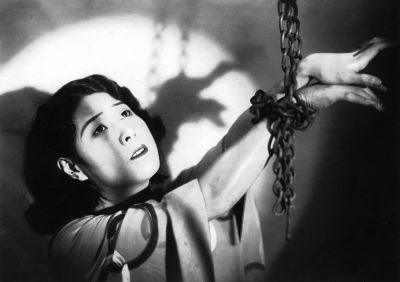
JORIKU DAI-IPPO
(First Steps Ashore/Primi passi sulla terra ferma, Giappone/1932)
R.: Yasujiro Shimazu. D.: 88'. V. giapponese
Benché poco noto in Occidente, Yasujiro Shimazu è una figura fondamentale del cinema giapponese d'anteguerra e un pioniere del gendai-geki (film d'ambientazione moderna). Negli anni Venti, quando lavorava negli studi cinematografici Shochiku di Tokyo, grazie all'incoraggiamento del direttore della compagnia Shiro Kido, Shimazu decise di girare commedie leggere d'ambientazione contemporanea come Chichi [Padre, 1923] e Nichiyobi [Domenica, 1924]. Questi film prefiguravano lo shomin-geki, il dramma della gente comune che divenne la specialità della Shochiku e nel quale si cimentarono con brillanti risultati registi quali Yasujiro Ozu, Mikio Naruse e Keisuke Kinoshita.
Storia di un marinaio che salva una donna dal suicidio per poi innamorarsene, Primi passi sulla terraferma fu il secondo film sonoro della Shochiku e il primo di Shimazu. Rifacimento del muto di Josef von Sternberg I dannati dell'oceano (1928) - considerato da "Kinema Junpo" il miglior film straniero distribuito in Giappone nel 1929 -, era ambientato nel porto della cosmopolita Yokohama. Il film di Sternberg era già stato adattato per il teatro shinpa nel 1931. Il testo teatrale e la sceneggiatura cinematografica sono opera di Komatsu Kitamura ed entrambe le versioni erano interpretate dall'attrice Yaeko Mizutani. Come osserva Mitsuyo Wada-Marciano, "Nel processo di adattamento del film dal muto al sonoro [...] il cineasta non si limitò ad aggiungere il dialogo, ma usò anche l'influenza del teatro shinpa - evidentissima nella recitazione e nella dizione di Yaeko Mizutani - per 'nipponizzare' la sceneggiatura". Il film fu sesto nella classifica di "Kinema Junpo" dei dieci migliori film di quell'anno.
Shimazu lavorò assiduamente alla Shochiku e poi alla Toho fino al 1945, anno della sua morte. Tra i suoi film sonori successivi si contano adattamenti da opere letterarie come Okoto to Sasuke [Okoto e Sasuke, 1935], tratto da un romanzo di Junichiro Tanizaki, e drammi realistici quali Tonari no Yae-chan [La nostra vicina Miss Yae, 1934] e Ani to sono imoto [Un fratello e la sua giovane sorella, 1939]. Malgrado la morte prematura, Shimazu esercitò un'influenza fondamentale sul cinema giapponese del dopoguerra (Heinosuke Gosho, Yuzo Kawashima, Keisuke Kinoshita, Senkichi Taniguchi, Shiro Toyoda e Kozaburo Yoshimura furono suoi assistenti) e svolse un ruolo centrale nello sviluppo di un genere essenziale del cinema d'autore giapponese.
Though little known in the West, Yasujiro Shimazu is a key figure in prewar Japanese cinema, and one of the pioneers of the gendai-geki (film of contemporary life). In the 1920s, working at Shochiku's Tokyo studio in Kamata, he began, with the encouragement of studio head Shiro Kido, to realize light comedies with contemporary settings, among them Chichi (Father, 1923) and Nichiyobi (Sunday, 1924). These films prefigured the shomin-geki, the drama of the lower middle classes, which was to become Shochiku's speciality and to which such directors as Yasujiro Ozu, Mikio Naruse and Keisuke Kinoshita were to make distinguished contributions.
The story of a sailor who begins a love affair with a woman he saves from suicide, First Steps Ashore was Shochiku's second sound film and Shimazu's first. It is a reworking of Josef von Sternberg's silent classic The Docks of New York (1928) transplanted to the waterfront of Japan's cosmopolitan port city, Yokohama. Sternberg's film had been named the best foreign film to be released in Japan in 1929 by the country's leading film magazine, "Kinema Junpo", and it had already been adapted for the Japanese stage in 1931 as a shinpa play. The same scenario writer, Komatsu Kitamura, worked on both the stage play and the film, and both starred the same actress, Yaeko Mizutani. As Mitsuyo Wada-Marciano observes, "In the process of adapting the film from silent to sound [...] the filmmaker not only added words, but also used the shinpa theatrical influence - most evident in Mizutani's acting and elocution - to 'Japanize' the script". The film took joint sixth place in the "Kinema Junpo" Best Ten for that year.
Shimazu was to work prolifically at Shochiku and then Toho up to his death from stomach cancer in 1945. Among his later sound films, he produced literary adaptations such as Okoto to Sasuke (Okoto and Sasuke, 1935), based on Junichiro Tanizaki, and realist dramas such as Tonari no Yae-chan (Our Neighbour Miss Yae, 1934) and Ani to sono imoto (An Older Brother and His Younger Sister, 1939). Despite his early death, he was a crucial influence on postwar Japanese film: Heinosuke Gosho, Yuzo Kawashima, Keisuke Kinoshita, Senkichi Taniguchi, Shiro Toyoda, and Kozaburo Yoshimura all served as his assistants, and he was a key figure in the development of a generic tradition central to Japanese film art.

Tariffe:

Numero posti: 174
Aria Condizionata
Accesso e servizi per disabili
Il nostro cinema aderisce al circuito CinemAmico: è possibile utilizzare l’applicazione MovieReading® per i film di cui è prevista audiodescrizione e/o sottotitolazione sull'applicazione.
Tel. 051 2195311











